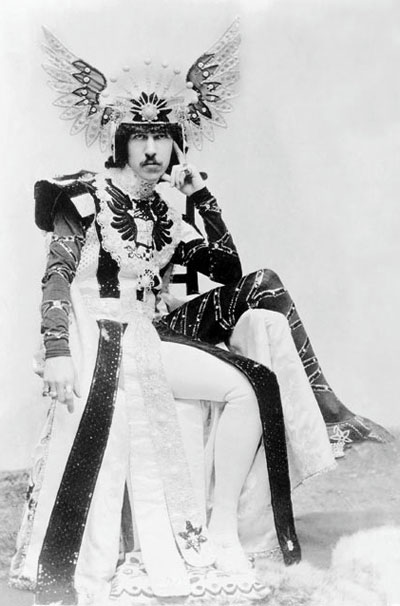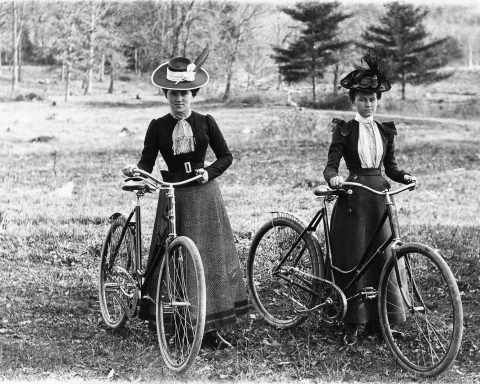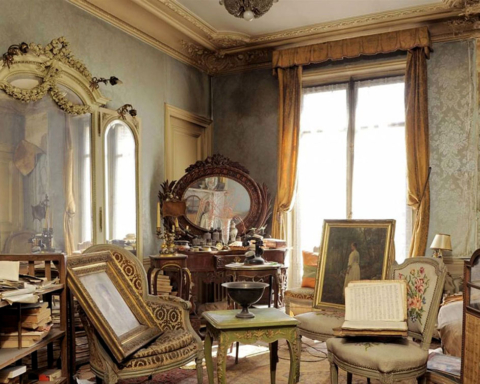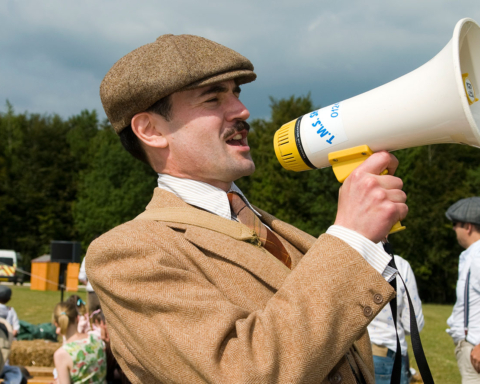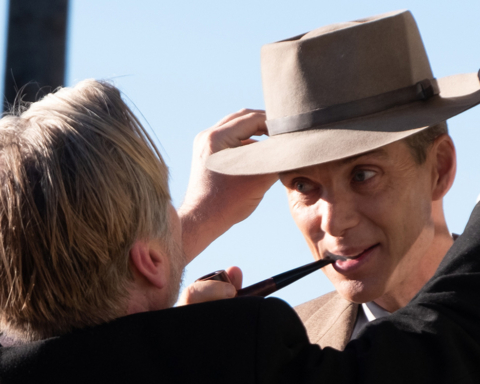Nathanial Adams:
On 13th October 1898, the fourth Marquess of Anglesey died at the family seat of Plas Newydd, an estate won by the First Marquess for the price of one leg at Waterloo (his bloody trousers are still on exhibit there.) His heir, Henry Cyril Paget, was now the Fifth Marquess, newly-minted master of considerable wealth (about £110,000 per annum,) and property (about 30,000 acres.) The proud new owner surveyed his land and took the next logical step: he hired architects and decorators at great cost, converted the family chapel into a 150-seat theatre modeled on the Dresden Opera House, and named it the Gaiety Theatre.
The Fifth Marquess was described by Clough Williams-Ellis as “a sort of apparition – a tall, elegant and bejeweled creature, with wavering elegant gestures, reminding one rather of an Aubrey Beardsley illustration come to life.” The Omaha Daily Bee described him more bluntly: “He is a thoroughly effeminate looking young fellow and he may be seen when in Paris walking around with a toy terrier under his arm, the pet being heavily scented and bedizened with bangles and bows. The fingers of the marquess fairly blaze with rings. He presents the characteristics of the Gypsy type.”
The exhaust pipe on the Marquess’s car was modified to spray scent: sometimes violet, sometimes patchouli, sometimes l’eau d’Espagne
Henry Paget’s lifestyle was no less lavish; one newspaper reported that his bedroom was “draped in mauve velvet, with hanging figures of solid silver. Its ornaments were of filigree and gold, and its tables crowded with bottles of the most costly perfumes. His ‘boudoir’ was of green and gold. He had three valets and a ‘coiffer,’ all of whom earned their high salaries, for it was no unusual thing for this modern Beau Brummell to spend a whole morning ‘working out’ some special scheme of color by dint of combining the effects of neckties, trousers, waistcoats and ‘spats,’ discarding, one by one, such as failed to ‘harmonise.’”

A few months earlier, Paget had married his cousin Lilian Chetwynd, in an arrangement that would allow them to inherit some funds which would have been off-limits otherwise. The couple separated almost immediately – according to some on grounds of non-consummation. Free from the bonds of matrimony and flush with cash, the Marquess indulged his dramatic passion. In 1901 he hired a company of professional actors at an inflated salary to go on a European tour with him. They travelled with their own orchestra and needed five trucks to carry their scenery and equipment. The jewel-covered costumes for his pantomimes, in which he always played the lead, were extravagant: a Henry V costume cost £40,000, and one for Aladdin may have cost as much as £100,000. Paget travelled in a custom automobile modelled after a Pullman railcar, complete with leather furniture, wooden fixtures and a baroque carved ceiling. The exhaust pipe was modified to spray scent: sometimes violet, sometimes patchouli, sometimes l’eau d’Espagne.
When “Toppy,” as he was known to friends, played the great dandy Lord Goring in his own production of Oscar Wilde’s “An Ideal Husband,” his manager said that “the part might have been written for him, he went through it so naturally.” It should also be noted that putting on a Wilde play was itself a daring thing to do, so soon after his trial and death. But Paget’s most famous act was the “Butterfly Dance,” which earned him the nickname “The Dancing Marquess.” He would perform this during the intermissions of his productions, after which he would hand out picture postcards of himself to the undoubtedly bewildered audiences.

Lord Berners was in the audience at one of the Marquess’s “performances” in Munich, and he said that it “came between that of a lady with performing pigeons and a company of acrobats. The theatre was darkened. There was a roll on the drums and the curtain went up on Lord Anglesey, clad in a white silk tunic, a huge diamond tiara on his head, glittering with necklaces, brooches, bracelets, and rings. He stood there for a few minutes motionless, without any mannequin gestures of display. Then the curtain went down again … The German audience seemed a little disconcerted by the manifestation of British eccentricity.”
Perhaps the root of Paget’s dramatic persona was his upbringing. When his mother died, he was sent to live with the French actor Benoit-Constant Coquelin, whom many suspected to be his true father. One of Paget’s friends pointed out that “little time was spent with British boys of his own age. Unfortunate surroundings in youth tended to make him perhaps a little un-English.”
By 1904 the Marquess was bankrupt, with debts totaling £544,000. Like so many great dandies before him, he moved to France and his estate was sold at auction. The sale lasted 17 days, and among the items were 260 pairs of gray kidskin gloves, 200 gold scarf pins, 280 pairs of socks, and the world’s biggest private collection of walking sticks – over 200 of them, many covered in jewels. Paget owned 30 pairs of silk pyjamas that one newspaper described as “dreams of oriental splendor.” His 240 waistcoats “were found too loud even for stage work. Some of them were covered with spangles, with contrasts of color that were blinding. One of blue peacock with iridescent feathers.” Among Toppy’s 100 dressing gowns, many by Charvet, one was made of purple silk lined with grey squirrel and one of gold brocade. Some of the more notable of his 100 overcoats were two melton coats, one lined with mink and one lined with Persian lamb; a silver-grey moleskin coat with a raccoon collar, and a brown sable overcoat which included 20 tails and 10 heads. He had boots of leather, crocodile and suede, and 200 pairs of slippers. As one newspaper put it, he owned “a complete collection of everything that could be strapped, buckled or laced upon the foot of man.”
In addition to this, the Marquess had an Astrakhan smoking jacket, a white suede evening suit which he wore with a black shirt and collar, and a “smoking suit of silver-grey silk with trousers of robin egg blue. On the white silk facings were embroidered sprays of forget-me-nots and wood violets.”
Paget moved to Monte Carlo, convinced he’d figured out a surefire system to beat the bank at the casinos. A reporter from the Daily Mail visited him and said that he “lives a retired life amid perfumes, hair tonics and cheap jewellery.” The Marquess was aware of his reputation and it seemed that he wanted to play it down. He said to the reporter, “I must apologise for not appearing before you in peacock-blue plush, wearing a diamond and sapphire tiara, a turquoise dog-collar, ropes of pearls and slippers studded with Burma rubies; but I prefer, and always have preferred, Scotch tweed.” It wasn’t a very convincing defence. He continued: “I never received anyone in my life attired in a purple dressing gown and sipping a liqueur. I may have a hobby for collecting pins and rings, but I never wore more than one of the former and four of the latter at the same time. And if I do use “scent,” I am not the only living person who does, am I?”
The Marquess, in fact, didn’t live much longer. He died in Monte Carlo in 1905, just a year after his bankruptcy. The title passed to his cousin, who immediately set about destroying the 5th Marquess’s papers and turning the Gaiety Theatre back into a chapel. The obituaries were severe in their judgment. The Daily Dispatch mentioned “the appalling fact that from his earliest recollection he had been one of those extraordinarily isolated creatures who have never known affection. From boyhood to death no-one had ever loved him….a strange and repellent spirit opaquely incomprehensible and pathetically alone…Over all was the self-conscious, half-haughty timidity of the man who knows he is not as other men.”
The Bystander was even less charitable: “His example will remain one of the strongest arguments against our hereditary system that the most ardent revolutionary would wish for.”

The Saint Paul Globe, however, gave the most honest and succinct account: “His prodigalities in jewels and clothing were enormous. His house parties and private theatricals excited the wonder of London, Paris, and Berlin. His personal eccentricities kept him constantly in the public eye. He perfumed his automobile with violets. He wore primroses in his hair. He wore women’s clothing. He appeared on the vaudeville stage in several cities in Europe in the costume of a ballet dancer. He imitated the serpentine and fire dances of Loie Fuller, wearing draperies spangled with diamonds, emeralds, and rubies costing $200,000. He spent $1,000,000 for jewels in a single year. There was no splendour, however barbaric, that the eccentric young marquis did not attempt to achieve, no extravagance he was unwilling to attempt.”

